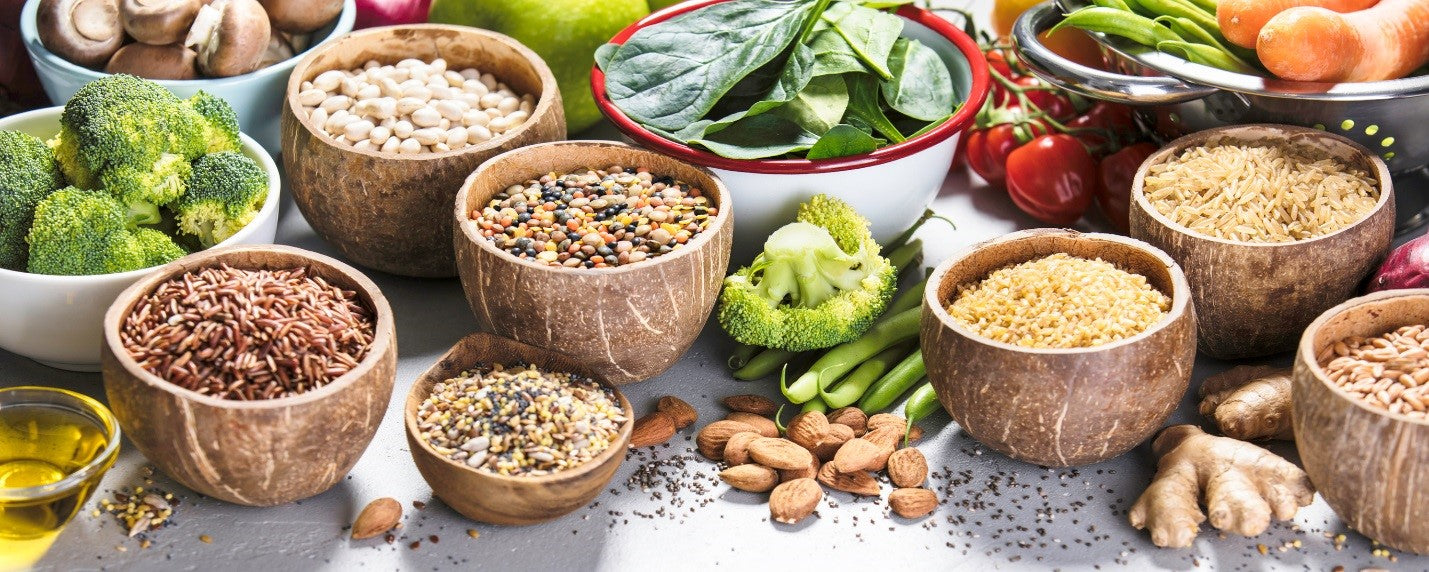There is no an product in your account
please add some product to cart.
11 High Fiber Foods You Need to Buy
Posted by John Coppola on 06 Jun, 19
We all know we need more fiber in our diet, but most of us are falling short when it comes to getting enough fiber daily. Dietary fiber is the carbohydrate in plants that your body cannot digest. Although it’s essential to your gut and overall health, most people never reach the recommended daily amounts.
The American Heart Association suggests consuming a total 25 to 38 grams of fiber per day from whole foods for women and men, respectively.
Over 100 years ago, in natural hunter-gatherer communities, average fiber intake ranged between 50 to 100g each day. To put that in perspective with modern day diets, the average American only consumes about 15g of fiber, daily. This is extremely problematic because high fiber foods protect us from cancer, heart disease, diverticulosis, kidney stones, obesity, and, support a healthy digestive tract.
Health Benefits of Eating High Fiber:

- Reduces risk of chronic disease
- Reduces the risk of colon cancer
- Increases metabolism
- Reduces inflammation
- Lowers cholesterol (Total and LDL)
- Reduces triglycerides
- Increases HDL
- Lowers risk of coronary heart disease, stroke, hypertension
- Lowers Blood sugar
- Reduces incidence of diabetes
- Reduces obesity
- Reduces the risk of certain gastrointestinal diseases (diverticulitis/diverticulosis, IBS, Ulcerative colitis, appendicitis, peptic ulcers, hiatal hernias, hemorrhoids)
There are two types of fiber: Insoluble and Soluble.
Both soluble and insoluble fiber help bulk up your stools and can be used as a food source for good bacteria in your large intestine.
Soluble fiber draws water into your gut turning the fiber into a gel-like substance during digestion. This helps bulk up your stools and reduce constipation. It, also, helps you feel fuller while lowering your cholesterol (LDL) and blood sugar levels.
Types of soluble fiber include:

- Avocado
- Oat bran
- Barley
- Figs
- Nuts
- Seeds (Chia, Flax, Sunflower)
- Beans
- Lentils
- Apples
- Guavas
- Peas
- Pears
- Nectarines
- Apricots
- Sweet potatoes
- Turnips
Additionally, soluble fiber assists in slowing your digestion, allowing for a slower and more stable release of glucose into your blood stream. The end result, it prevents blood sugar dips and spikes and helps to regulate the hormones that play a major role in appetite control. Soluble fiber is fermented by the colon’s microorganisms and bacteria.
Insoluble fiber is helpful in scouring the pockets of your intestines. It comes from the roughage from fruits, vegetables, grains and some nuts and seeds. One of the main jobs of insoluble fiber is to provide bulk in the intestines. Unlike soluble fiber, insoluble fiber does not dissolve in water, so it helps move waste material through the colon by increasing the bulk of stools. It also helps to control and balance pH (acidity) in the intestines. Insoluble fiber is not fermented by the gut’s bacteria.
Insoluble fiber has many health benefits.
- Slows down the absorption of carbohydrates and sugar
- Helps maintain healthy blood sugar levels
- Helps with appetite control and weight management
- Helps prevent diverticulosis and hemorrhoids
- Removes toxic waste through the colon in less time
- Lowers the risk for Colorectal cancer (by keeping an optimal pH in the intestines preventing microbes from producing cancerous substances).

Foods with highest levels of insoluble fiber
- Cruciferous vegetables (broccoli, brussels sprouts, cauliflower, cabbage, kale)
- Carrots
- Spinach
- Beans
- Fruit with skin
- Wheat and Wheat Bran
Another type of fiber to consider is Prebiotic Fiber, also known as the ‘Gut Fertilizer’. This type of fiber is easily fermented by our gut, feeding and nourishing the friendly bacteria present in the gut. Prebiotics can be denatured when cooked so they’re best eaten raw.
Good source of Prebiotic fiber

- Chicory Root
- Dandelion Greens
- Jerusalem Artichoke
- Garlic
- Onions
- Leeks
- Asparagus
- Unripe green bananas
- Cacao
- Burdock Root
- Flaxseeds
- Yacon Root
- Jicama Root
- Seaweed
Insights

Here’s the thing…
Fiber-rich foods are going to be a mixture of all of the above. In almost every fiber-rich food source you will find a combo of insoluble and soluble fibers, some simply having more of one type of fiber than the other. So don’t stress about which one you should include more.
The goal: Aim for at least 25g of fiber per day.
Here’s a list of high-fiber foods to help you meet your goal:
Chia Seeds
Fiber: 10 grams per 1-oz serving
Chia seeds are little fiber bombs! Higher in soluble fiber when mixed with liquid. Throw them in your oatmeal or smoothies.
Pears
Fiber: 5.5 grams in a medium-sized pear.
Juicy, delicious, and high in fiber, pears generally top the list of being the fruit with the highest fiber content.
Flaxseed
Fiber: 3 grams per tablespoon
With a nice mixture of soluble and insoluble fiber, flaxseed is a great little fiber-boosting option. They go great in smoothies.
Oats
Fiber: 4 grams per cup (cooked)
There’s a reason why “reduces cholesterol” or “is good for heart health” appears on oatmeal labels: the cereal contains a type of soluble fiber called beta-glucan, which is what gives it its creamy consistency.
Black Beans
Fiber: 17 grams per cup
Most beans and legumes are going to be a winner in the fiber department, but black beans top the list. One cup of black beans has five grams of soluble fiber, along with another 12 grams of insoluble fiber. Other beans that follow closely behind are navy, red, and kidney beans.
Broccoli
Fiber: 2.4 grams per cup
Most veggies are good sources of fiber. Throw a combination together for your dinner and you’ll have a healthy serving of fiber along with a long list of other health benefits.
Quinoa
Fiber: 5.2 grams per cup of cooked quinoa
A great grain to include to boost your intake of fiber. It tastes great hot or cold. Quinoa is also, loaded with many other nutrients, including protein, magnesium, iron, zinc, potassium, and antioxidants, just to name a few!
Avocados
Fiber: 10.1 grams per cup
The fiber content of avocados varies depending on the type. There is a difference in fiber content between the bright green, smooth-skinned avocados (Florida avocados) and the smaller, darker and dimpled variety (California avocados). Florida avocados have significantly more insoluble fiber than California avocados. In addition to the fiber, avocados are packed with healthy fats that help lower cholesterol and reduce the risk of heart disease.
Berries
Coconut
Fiber: 7.2 grams per cup
Coconut has low glycemic index and four to six times the amount of fiber as oat bran.
Figs
Fiber: 1.9 grams per large fig
Figs are a great source of fiber. Unlike many other foods, it has a near perfect balance of soluble and insoluble fiber. Figs are also associated with lower blood pressure and protection against macular degeneration.
If right now, you consume a diet very low in fiber, then we recommend a gradual increase in your fiber. Otherwise, you may experience some gas and bloating. If you do experience gas or bloat, simply supplement with a digestive enzyme.
 This blog has been provided by Dr. John Coppola, D.C. and Dr. Valerie Monteiro, D.C. Dr. Coppola and Dr. Monteiro are the founders of the San Antonio Neuropathy Center, and Precision Sport & Spine. They are the leading experts in the field of neuropathy and specifically drug free nerve repair. They are the authors of the critically acclaimed book "Defeat Neuropathy Now .... In Spite of Your Doctor. The doctors have over 25 years of clinical experience.
This blog has been provided by Dr. John Coppola, D.C. and Dr. Valerie Monteiro, D.C. Dr. Coppola and Dr. Monteiro are the founders of the San Antonio Neuropathy Center, and Precision Sport & Spine. They are the leading experts in the field of neuropathy and specifically drug free nerve repair. They are the authors of the critically acclaimed book "Defeat Neuropathy Now .... In Spite of Your Doctor. The doctors have over 25 years of clinical experience.
If you would like to reach the doctors regarding a specific health problem, you may email them at info@bodiesrebuilt.com.
References
Carla R. McGill, Victor L. Fulgoni, III, and Latha Devareddy. “Ten-Year Trends in Fiber and Whole Grain Intakes and Food Sources for the United States Population: National Health and Nutrition Examination Survey 2001–2010”. Nutrients. 2015 Feb; 7(2): 1119–1130.
Melissa M. Kaczmarczyk, Michael J. Miller, and Gregory G. Freund. “The health benefits of dietary fiber: beyond the usual suspects of type 2 diabetes, cardiovascular disease and colon cancer”. Metabolism. 2012 Aug; 61(8): 1058–1066.
Joanne Slavin. “Fiber and Prebiotics: Mechanisms and Health Benefits”; Nutrients. 2013 Apr; 5(4): 1417–1435.
Colorado State University Extension: Dietary Fiber
Harvard University Health Services: Dietary Fiber
U.S. Department of Agriculture and U.S. Department of Health and Human Services: Dietary Guidelines for Americans 2010
Fiber Content of Foods in Common Portions by Harvard University Health Services, dated May 2004, and, Food Sources of Fibre by Dietitians of Canada, dated Jul 27, 2012.





